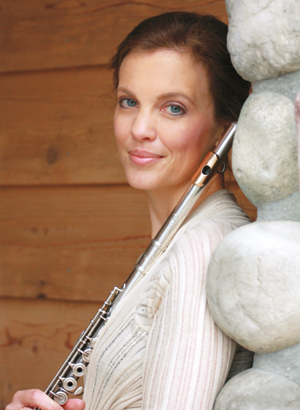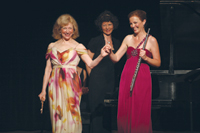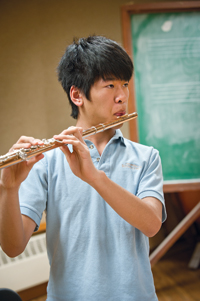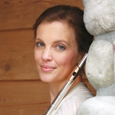 Nancy Stagnitta has been the flute professor at the Interlochen Arts Academy for the past ten years. She shares her background and ideas about teaching these remarkable young musicians.
Nancy Stagnitta has been the flute professor at the Interlochen Arts Academy for the past ten years. She shares her background and ideas about teaching these remarkable young musicians.
How do you balance a full-time teaching position with a career as a performer?
As my career has evolved, the elements of teaching and performing have become increasingly more symbiotic. Working on my own playing helps me to be a more effective teacher, and working with bright and eager students, as I am fortunate to do at Interlochen, brings profound inspiration and insight to my playing.
I could not have foretold the path I would encounter after leaving Peabody. Although it has been filled with adventure and unexpected turns, it has always included a balance of performing and teaching on some level. After finishing my graduate work at the Peabody Institute, I joined the Baltimore Opera Orchestra, and later the Sarasota Opera, playing piccolo in both. I traveled to Africa to give recitals and masterclasses for the U.S. Information Agency as an Artistic Ambassador. Throughout this time, I was teaching flute at the Waldorf School of Baltimore, where I worked for fifteen years. I had an active freelance career in the Baltimore/Washington area, performing with the Annapolis Symphony, occasionally subbing with the Baltimore Symphony, and playing jazz. In 1999 I first taught at the Interlochen Summer Arts Camp. I loved the variety of activity and the wonderful opportunities for travel and versatility, and I still do. I also enjoy having a home base amidst the peaceful woods of northern Michigan, and working full-time with the students at Interlochen.
I can still remember the first time I travelled to Interlochen from Baltimore. Those last hours as I drove into the upper lower peninsula of northern Michigan seemed endless, but there is something quite magical about it. The serene beauty lends itself to tremendous focus and artistic inspiration.
In this economy do you encourage your students to pursue a career in music?
This is a very significant and weighty question for every arts educator to consider with great care. It is both a privilege, and oftentimes a daunting responsibility, to guide future artists into a world filled with so many unknowns. I feel that one of the most crucial parts of my job is to help students to grasp the depth of their potential, identify their strongest gifts and greatest aptitudes, and embark on the career path that is most appropriate and offers the greatest potential for creating success and fulfillment.
When I encounter a student who has the drive, focus, and capacity for hard work combined with the musical sensibility and technical mastery necessary to pursue a professional career as a flutist, we work together toward that goal full force. Many students choose careers in the arts outside of the performance realm, such as administration, education, music therapy, and public radio. Others utilize the skills they have honed as flutists in a wide variety of career paths. In the past decade, graduates of the flute studio have gone on to study law, medicine, organic farming, child psychology, elementary education, and foreign language and policy, among many other fascinating fields of study. There are great flutists out there in every profession. Interlochen is a remarkable training ground for young artists, and it can also help students to discern whether a career in performance is the right choice for them.
How do you help a student build a technique?
Carefully, and from the ground up. Mindful practice is the name of the game, and it begins with the body. I start with posture, balance, and alignment. The flute is an extension of the body, and the vessel through which we tell the tale set forth to us by the composer. If the body is not free of tension and prepared to resonate with flexibility and ease, coupled with appropriate strength, both the tone and the technique will suffer.
My technical warm-up regimen addresses all of the essential elements necessary to building a strong fundamental ability and a solid understanding of flute playing. I encourage slow practice of small gestures and passages first, gradually leading to faster work. Many times, a student will work on a passage slowly and thoughtfully, gradually working to play it faster, only to find that he reaches a point where all the careful work seems to fly out the window. The progress gained in the slow practice is replaced by tension, old habits, and inaccuracy. This can be frustrating. It is so important to work on good skill very slowly, always listening and assessing, and then to take that same skill with you when you play faster. Don’t leave it behind. This seemingly obvious concept can be stubbornly difficult in practice. The brain needs training just as the tongue and fingers do. I encourage students to work calmly with impeccable focus and to keep their sights set on making the music happen. This lets the brain and the body work together toward effortless execution.
How do you help students find personality in their sound?
I encourage students to do a great deal of listening – first to the great flutists and singers, but also to violinists, cellists, and a broad spectrum of others. This is an important step toward defining and honing each student’s concept of sound, and finding his true voice on the flute. We start with the elemental building blocks of producing sound on the flute. This includes the exploration of air pressure and control, the shape and direction of the air column, inner resonance, the embouchure, tongue placement, and of course, vibrato. When it comes to the more nuanced aspects of each student’s sound, this becomes much more personal. My job shifts from one of instructing the basics to one of gaining a glimpse into the student, who they are, and the qualities that most accurately define the sound and the voice they wish to express. Then we work to balance these qualities with what is necessary to create a strong, beautiful, and personal tone.
Since you have so many senior students auditioning for conservatories each year, how do you select their audition materials?
Selecting audition repertoire can be a very stressful part of the college audition preparation process for students. There are variety of considerations. First, the student should be excited to work on it, so the music remains fresh throughout the process. The music should show versatility and understanding of a wide variety of styles, as well as confidence and artistry. It also should demonstrate appropriate ability level. I recommend choosing the minimum amount of repertoire that will cover the audition requirements for all the schools on a student’s list.
Where do your students go to continue their studies?
Nearly all of my senior students attend a conservatory, college, or university following their years at Interlochen. In the past ten years, students have attended institutions such as The Juilliard School, Curtis Institute, New England Conservatory, Eastman School, Oberlin, San Francisco Conservatory, Cleveland Institute, Rice, Northwestern, the University of Colorado at Boulder, McGill, The Longy School, Harvard, and many others. A few students elect to continue their studies at Interlochen for a post-graduate year of concentrated study.
What are you looking for in a student who auditions for entrance into the Interlochen Arts Academy?
I enjoy meeting students who are confident and enthusiastic about the audition. In the heat of the moment, it can be difficult for a student to remember that this is an exciting time, but it is immediately palpable when a young player enters the room with a positive, confident, and engaged approach. I look for flutists who are communicative, talented, focused, and genuinely interested in improving their skills, both technically and artistically. I listen for careful preparation, solid knowledge of the repertoire, and strong potential for growth. I especially like to hear a beautiful sound, good rhythmic integrity, and an obvious and genuine commitment to the music.
How much do your students practice?
This varies depending on the student. Some students come to Interlochen as entering freshmen, however many also enter in later years, up to and including the post-graduate year. The amount of practice for each student is determined by where the flutist is in his development, what his future aspirations are, and what type of academic load he is taking.
Generally speaking, my students practice between two and five hours a day. This will vary depending on upcoming performances, auditions, or competitions. I always recommend stretching and taking breaks in long practice sessions, to keep both mind and body up to the task at hand.
Do you have any tricks for motivating students?
I encourage students to consider the quality of their work at all times, on every note and in every breath, rather than allowing practice to become tedious or operate in automatic pilot mode. This can lead to diminishing returns quite quickly. The adage practice makes permanent is a good one. My students are required to write weekly practice summaries, in which they reflect on their progress throughout the week and their goals going forward. This helps them to become insightful observers of their own practice. I also require students to record their lessons and practice sessions, and then to review their progress.
What prepared you for this teaching position?
My time as a student, both in high school and as a conservatory student at Peabody, as well as the culmination of all the experiences I had had as a performer and a teacher, helped to prepare me for my current position at Interlochen. I was an academically motivated student as well as a serious flutist, and this allows me to relate to both the rigors and the rewards associated with balancing intensive artistic study with academic life.
Where did you grow up?
I spent my childhood in Hyde Park, New York, in the mid-Hudson Valley. When I was eight years old, my family moved to Germany for a year, and I spent that year in a German school in the small town of Grafenau-Döffingen, near the Black Forest. While there, I continued the piano lessons I had begun back home at age five. I decided to begin playing flute when I returned to the U.S. for fourth grade.
What interested you about music?
My parents are great music lovers, and they always had very eclectic taste. I grew up hearing symphonic music, Italian opera, big band era swing, and various representations of the pop music of the time, both in the house and on endless repeats of 8-track cartridges on car trips. As a young child, I loved singing along, making up harmonies, daydreaming and dancing to the music. I recall one particular day when I had been inspired to come up with some very dramatic dance moves to the opening of Richard Strauss’ Also Sprach Zarathustra playing on the stereo. I can also remember how mortified I was when I realized that my mom and dad had been observing this spectacle on the sly.
Who were your major influences?
My first instrumental music teacher in public elementary school, David DeWitt, was an accomplished flutist. A former member of the Hudson Valley Philharmonic and the West Point Academy Band, he was an encouraging first teacher who nurtured my love and early affinity for the flute. I also worked with another fine flutist in my town, Judith Handman, and then throughout high school I studied with a former student of Joseph Mariano, Beatrice Keram. She was a devoted and demanding teacher who helped me to understand how hard I would have to work in order to move to the next level.
When I was a teenager, my parents took me to New York City to hear both James Galway and Jean-Pierre Rampal perform solo recitals. During that same time, I played in a masterclass for Paula Robison and heard her perform in Woodstock, New York. Looking back, the combination of having excellent flutists and caring teachers in my young life, coupled with hearing these luminary flutists at an early age, led me toward a career as a flutist. I spent a summer at the New York School for Orchestral Study at Saratoga, where I worked with Murray Panitz. I then went on to study at the Peabody Institute, where I was fortunate to work with Tim Day and then with his former teacher, Robert Willoughby for the last year of my undergraduate studies and for my Master’s degree. I also took a few lessons with some of the many wonderful players in the Baltimore and National Symphonies at the time, including Mark Sparks and Emily Skala for flute, and Laurie Sokoloff and Carole Bean for piccolo.
What is the legacy of Robert Willoughby?
What I remember most vividly about my lessons with Robert Willoughby is the questions.
His approach was not for me to ask questions of him in order to learn, but rather, he was the one asking questions of me. Where is this phrase going? Why are you emphasizing this note? Why not that one? He was craftily teaching me to make decisions – good ones – about every aspect of what I was doing, both in my flute playing and in my interpretation, after exploring all the possibilities. He also understood how crucial it was for me to have the ability to assess whether my intent was sound, and to discern whether my execution matched that intent with authenticity and conviction. I can recall moments of frustration, when I would think to myself, “Why won’t he just tell me the answer.” But that would have been the easy way, and not his wise and challenging, yet kind method. His gift was the greatest one a teacher can give to a student: to know how to become your own teacher. Not only has he cultivated a treasure trove of thoughtful musicians and fine players throughout the years, but also very astute and effective teachers.
 Since Interlochen has the winter Arts Academy and the summer camp programs, how do you spend your summers?
Since Interlochen has the winter Arts Academy and the summer camp programs, how do you spend your summers?
I teach at a one-week Summer High School Flute Institute at Interlochen along with Paula Robison and Judith Mendenhall, where we focus on artistry, technique, and a variety of repertoire in daily masterclasses, as well as incorporating improvisation, panel discussions, and Pilates exercises designed specifically for flutists. I also travel to various music festivals throughout the summer to teach and perform, currently at the Vianden International Music Festival and School in Luxembourg, and the Montecito International Chamber Music Festival in California. In previous years, I spent several weeks at the Amalfi Coast Music Festival in Italy. I also enjoy spending some time at home, where I give a masterclass at the Interlochen Arts Camp, play at several local jazz festivals, and take time to enjoy the gorgeous northern summers.
What goals and special projects do you have coming up?
I just recently returned from a trip to Shanghai, where I participated in the Shanghai Conservatory Middle School Program’s Third Annual Baroque Festival along with two colleagues from Interlochen. It was a fascinating trip, and I continue to be enchanted and inspired by traveling, and by meeting fellow musicians in other cultures. I look forward to doing more, and particularly to returning to Europe this summer. I have plans to begin working on a solo recording project in the near future, and will continue to perform as a member of the Traverse Symphony, the South Florida Symphony, and various other groups. I will also be exploring several new collaborative endeavors, as I did previously with a project entitled “Pilates, Physics, and the Healthy, Resonant Flutist,” conceived with my colleagues in the dance and physics departments at Interlochen.
* * * *
Interlochen Center for the Arts
 In the mid-1920s music in most American public schools was an extra-curricular activity that carried no academic credit. To stimulate interest in developing music programs, the Music Supervisors National Conference (later to become the Music Educators National Conference) asked Joseph E. Maddy to select and train a national high school honors orchestra to play at the group’s 1926 biennial meeting in Detroit. The success of this project produced an invitation to play for a national meeting of school superintendents in Dallas the following year, and a return to the MSNC in Chicago in 1928.The orchestras of 1926-1928 provided so powerful an experience for the young musicians in just a few days together that Maddy, along with Thaddeus P. Giddings, decided to create a place for these gifted young musicians to rehearse and perform together for an entire summer.
In the mid-1920s music in most American public schools was an extra-curricular activity that carried no academic credit. To stimulate interest in developing music programs, the Music Supervisors National Conference (later to become the Music Educators National Conference) asked Joseph E. Maddy to select and train a national high school honors orchestra to play at the group’s 1926 biennial meeting in Detroit. The success of this project produced an invitation to play for a national meeting of school superintendents in Dallas the following year, and a return to the MSNC in Chicago in 1928.The orchestras of 1926-1928 provided so powerful an experience for the young musicians in just a few days together that Maddy, along with Thaddeus P. Giddings, decided to create a place for these gifted young musicians to rehearse and perform together for an entire summer.
The National High School Orchestra Camp was incorporated in 1927, and Maddy began to search the country for a proper site. He was soon drawn to a state park area near Traverse City, Michigan where Willis Pennington had established a tourist hotel flanked by a camp for girls and one for boys, each on separate lakes. The National Orchestra and Band Camp opened in 1928 with 115 students and twenty-four faculty from across the country. Vacationers in the region soon flocked to the amphitheater in the forest to hear these young musicians play their weekend concerts. The summer was an artistic success, but with only about half the number of campers he planned for, Maddy had to call upon professional musicians, private donors, instrument-makers, and music publishers to help the organization survive. National network broadcasting that began in 1930 and continued through 1941 attracted more and more campers, and John Philip Sousa’s visits in the last two summers of his life drew crowds of thousands to hear the celebrated March King lead the band and orchestra. After 85 summers the camp now offers programs in all the arts to more than 2500 young students and adults.
In 1962 the Interlochen Arts Academy opened as the nation’s first independent boarding school in the arts. The school has grown from the initial 135 students with a faculty and staff of 34 to a four-year program for 475 young artists from around the world, representing 20 countries. The Academy offers students the opportunity to major in music, creative writing, dance, motion picture arts, theatre, the visual arts, and comparative arts. In 2006 the Interlochen Center for the Arts received the National Medal of Arts, the nation’s highest honor for artistic excellence. Besides a strong academic curriculum, music students receive an all-encompassing experience with private lessons, studio classes, master classes, music theory and other music electives plus performance in small and large ensembles. It is an environment where students are constantly challenged, motivated and inspired by their peers, teachers and guest artists. The experience prepares Interlochen students for entrance into leading music programs in conservatories, colleges, and universities.
Interlochen Arts Academy Flute Curriculum
Students enter with a wide range of musical experiences, and the flute curriculum is tailored to each student’s individual needs. Strong flute fundamentals are covered in great detail using a set of warm-up and technical exercises I have compiled over the years. The following is a selected list of materials that most students will study during their time at the Academy.
Technical and Tone Studies
Taffanel & Gaubert 17 Big Daily Exercises, Reichert Seven Daily Exercises, Op. 5, Moyse De La Sonorite
Etudes
Andersen, Altès, Berbiguier, Koëhler, Boëhm, Jeanjean, and Karg-Elert. I often ask a student to work out of one of the many excellent compilations available in order to have exposure to a broad variety of etudes.
Repertoire
Since most students will be auditioning for conservatory or college music programs during their senior year, repertoire is selected based on the student’s age, performance level, and the audition requirements for each school. The following list represents a sampling of the repertoire from which each student’s course of study may be drawn.
Baroque Era: Telemann Fantasies, Handel and Bach Sonatas
Sonata Repertoire: Reinecke, Poulenc, Hindemith, Muczynski
French Conservatoire Repertoire: Fauré Fantasie, Chaminade Concertino, Huë Fantasie, Dutilleux Sonatine, Sancan Sonatine, Jolivet Chant di Linos
Concerto Repertoire: Mozart, Nielsen, Ibert, Liebermann
Additional Representative Solo Repertoire: Griffes Poem, Copland Duo, Debussy Syrinx, Martin Ballade, Varèse Density 21.5, Jolivet Chant de Linos
Orchestral Excerpts
Basic Elements of Improvising and Playing Jazz
Photos courtesy of Interlochen Center for the Arts






